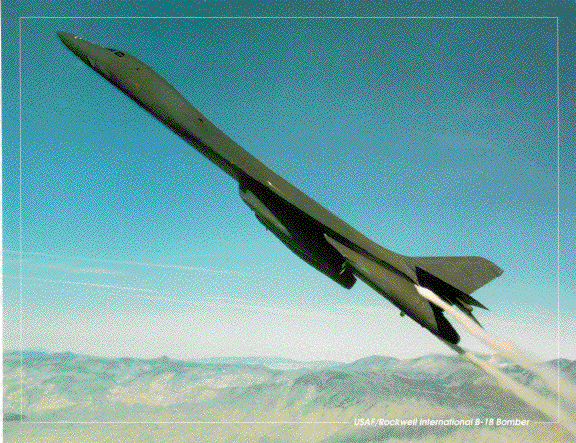
Hard to imagine we're already retiring these.
Posted on 05/09/2003 8:32:21 AM PDT by Stand Watch Listen
Encouraged by the B-1B bomber's strong showing in Afghanistan and Iraq, the Boeing program's backers plan to push for returning 12 retired bombers to operational status and to seek funds for new upgrades for the fleet."I'll be optimistic and say that [the B-1B's war record] is going to basically improve the B-1's long-term upgrade plan," Rich Parke, Boeing's director of advanced programs business development, said May 6.
An urgent question is whether to readjust the size of the B-1B fleet, Parke said. In 2001, Defense Secretary Donald Rumsfeld ordered the U.S. Air Force to retire 33 B-1Bs and divert some of the maintenance savings to pay for new upgrades, such as integrating the Lockheed Martin Joint Air to Surface Standoff Missile-Extended Range.
Flush with new operating data, Air Force and Boeing officials again plan to argue that the 60-bomber fleet is not enough. Air Force officials "would like another dozen" B-1Bs brought out of retirement, Parke said, adding that Boeing agrees with the service's estimate.
Air Combat Command keeps about 36 B-1Bs available for combat, and up to 24 were deployed during Operation Iraqi Freedom, Parke said. "A huge portion of the B-1 force structure was forward deployed" in February and March, he said, which strained training and maintenance schedules.
A decision is needed soon to avoid the expense of restoring at least some of the planes to operational status, Parke said. The Air Force has stripped the operational gear out of most of the retired B-1B fleet, but at least six aircraft are being held in reserve while some B-1Bs are being upgraded to the Block E configuration of the $1 billion Conventional Mission Upgrades Program.
"We have to make the decision right now," Parke said.
B-1B supporters also are campaigning to win funding for a handful of upgrade programs, such as integrating new defensive systems, radars and targeting pods, in the five-year budget planning cycle starting in fiscal 2006, he said.
Last week, Parke said, the Air Force awarded Boeing a small contract to study options for a replacement of the Defensive System Upgrade Program (DSUP), which was canceled in December after a string of costly program restructurings.
Boeing's study team, which reports to the Air Force later this summer, will consider a range of options, including the ALE-55 fiber optic towed decoy, upgrading the existing ALQ-161 system and emerging technologies.
Another proposal is to integrate an exterior targeting pod on one of the B-1B's hard points, such as the Litening II pod recently demonstrated in combat by a B-52 crew, Parke said. The pod would allow B-1B crews to confirm and laser-designate emerging targets, he said, rather than relying on fighters to do that.
Funding isn't the only obstacle to equipping B-1Bs with targeting pods. As conventional bombers, B-1Bs are banned from installing external hard points by the START I treaty, Parke said.
A further upgrade being proposed is a radar with a one-foot resolution, replacing the B-1B's 10-foot resolution system that can't distinguish a military jeep from a school bus, Parke said.
-- Stephen Trimble

Hard to imagine we're already retiring these.
Best looking military plane ever, IMO (next to the A-10, of course).
Apparently, the biggest problem with the B-1 is that it is more expensive to fly than the old B-52.





Disclaimer: Opinions posted on Free Republic are those of the individual posters and do not necessarily represent the opinion of Free Republic or its management. All materials posted herein are protected by copyright law and the exemption for fair use of copyrighted works.